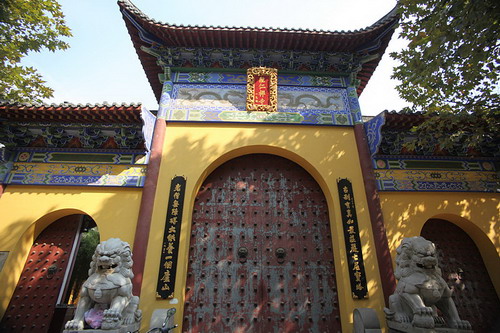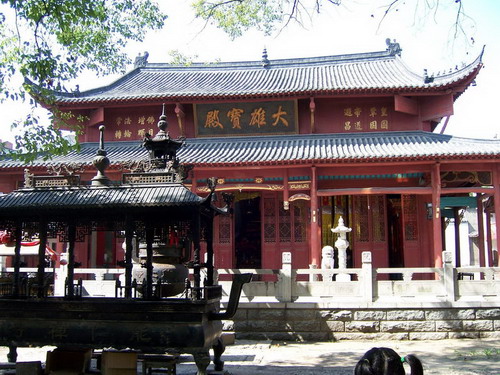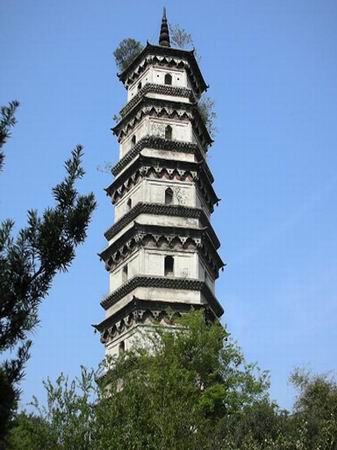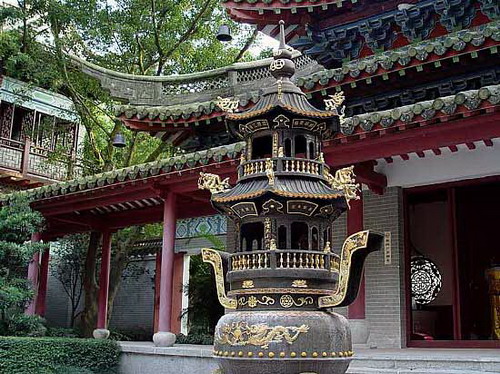Lofty Lushan Mountain
Temples in Hidden Places
On the First of August
Wheels by the Water
Share your travel story with regional@chinadaily.com.cn
Nengren Temple
( chinatour360.com, travelchinaguide.com )
Updated: 2011-09-14
 |
|
Nengren temple is the largest historical structure in Jiujiang city. |
Nengren Temple is located in the center of Jiujiang city, Jiangxi province. It was first built in the Southern Dynasty (AD 420-589), and went through many changes and repairs through the following dynasties. Most of the present structures in this temple were repaired or built in the Qing Dynasty (1644-1911). The temple covers an area of 3,000 square meters and is the largest historical structure in Jiujiang city.
The Nengren Temple now enjoys a rich history of 1,500 years full of a great many changes. According to historical records, it was first called Chengtian Courtyard and the buildings were not that many. During the Tang Dynasty (AD 618-907) when Buddhism was predominant, a sainted Buddhist named Bai Yun came across this desolate temple and began a restoration of the Great Buddha's Hall and the Great Victory Pagoda. From then on, the temple has attracted increasing numbers of prayers, and has played an important role in Chinese Buddhism. The Iron Buddha Hall was added in the Song Dynasty (960 - 1279).
In later ages, the temple was destroyed by warfare but rebuilt and repaired time and time again. With the restorations of the Qing Dynasty (1644-1911), finally the whole temple was renovated and revived to its former prosperity.
Nengren Temple is one of the major protected temples in China. The design of this temple is characteristic of Chinese architecture: natural, elegant and spectacular. Visitors can find grand halls and statues of Buddha, guardians, warriors, as well as relics and scriptures of Buddhism. This temple boasts eight charming sites: Great Victory Pagoda, Stone Boat, Iron Buddha, Twin Sun Bridge, Yuchuanshi, Hui'er Spring, Icy Hill and Snow Cave.
 |
| The main hall of the temple |
The Great Victory Pagoda, built in the Tang Dynasty (AD 618-907), underwent repairs in the Ming (1368-1644) and Qing dynasties. This pagoda, with its west-facing gate, is a 7-storied hexagonal structure made of bricks and stones. It is 43 meters (about 141 feet) high. From the second story on, there is a door on each side of the hexagon. Inside the pagoda, there is a brick staircase that goes to the top, where visitors can enjoy an overview of all the beautiful sceneries of Jiujiang city. This staircase is the only one of its kind remaining in China.
 |
|
Visitors can enjoy an overview of all the beautiful sceneries of Jiujiang city on top of the Great Victory Pagoda. |
The Stone Boat is a big concave stone which resembles a boat. It is 5 meters long, 1 meter wide and 6 meters deep. On the boat sits the Iron Buddha. Legend has it that in the Song Dynasty (AD 960-1279) a monk dreamed about an iron Buddha ferrying across the river in a stone boat. Unfortunately, this iron Buddha was destroyed and the existing one is made of concrete.
The Twin Sun Bridge, straddling a pool, is a three-arched stone bridge. It is renowned for the marvelous scene of two inverted images of the sun that can be seen from the east side of the pool.
The Yuchuan Stone (Raindrop Piercing through Stone) is a large piece of rectangular granite engraved with clouds, flowers and inscriptions. On its top is a funnel shaped hollow made from the constant dripping of water. This is a good example of the aphorism: “constant effort brings success.”
In reality, Hui'er Spring is a well with a history of more than a thousand years. It is said if a piece of copper is thrown into the well, an echo can be heard. The spring water is very pure and mellow. It is said that wisdom and understanding can be enhanced through drinking the water.
The Icy Hill is a piece of giant limestone with many holes. Mist is made when stream water spurts out continuously from the holes, looking like an icy hill.
The Snow Cave is another piece of giant limestone adjoining Icy Hill. It is said that there was a gate in this stone for people to come in and out of. In cold winter, the gate was plugged up by ice sticks, looking as white as snow. The cave was destroyed in 1930. Now, all visitors can see are their debris and two different stones replacing them.
Visitors can also learn about Buddhist culture by viewing the abundant relics and scriptures preserved in Nengren Temple. The Buddhist chants and music attract numerous devout prayers and visitors every year.
 |
| Inside the Nengren temple scenic area |




